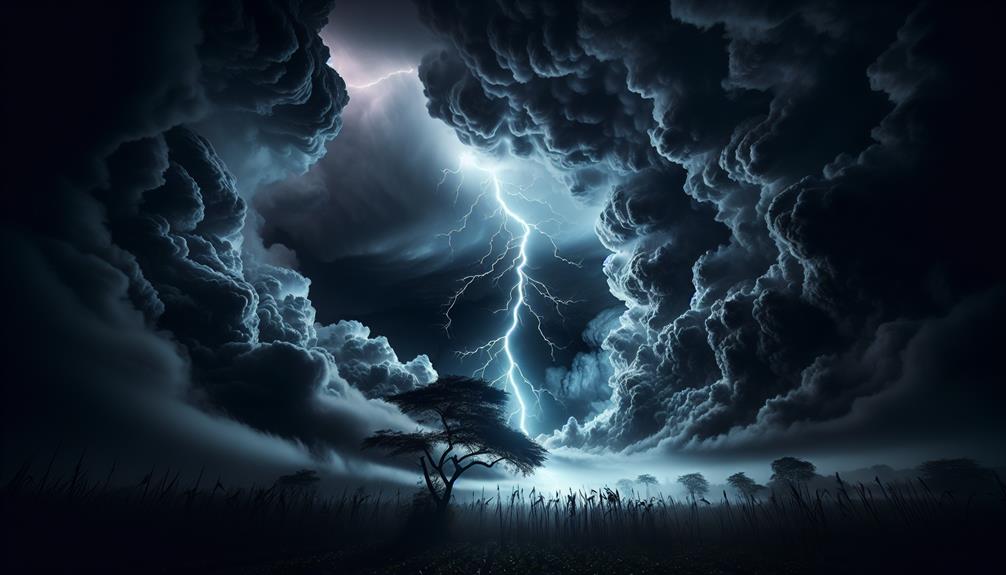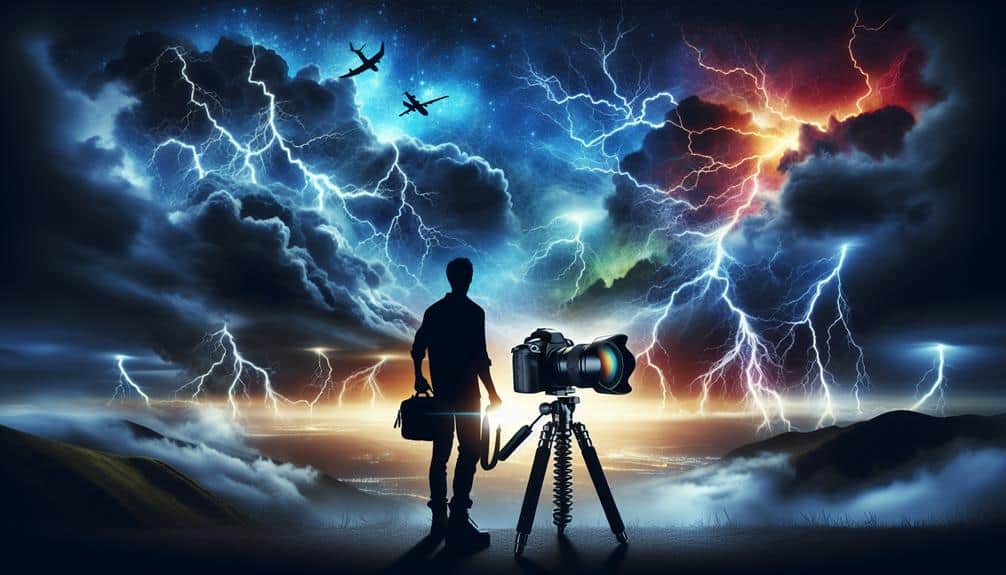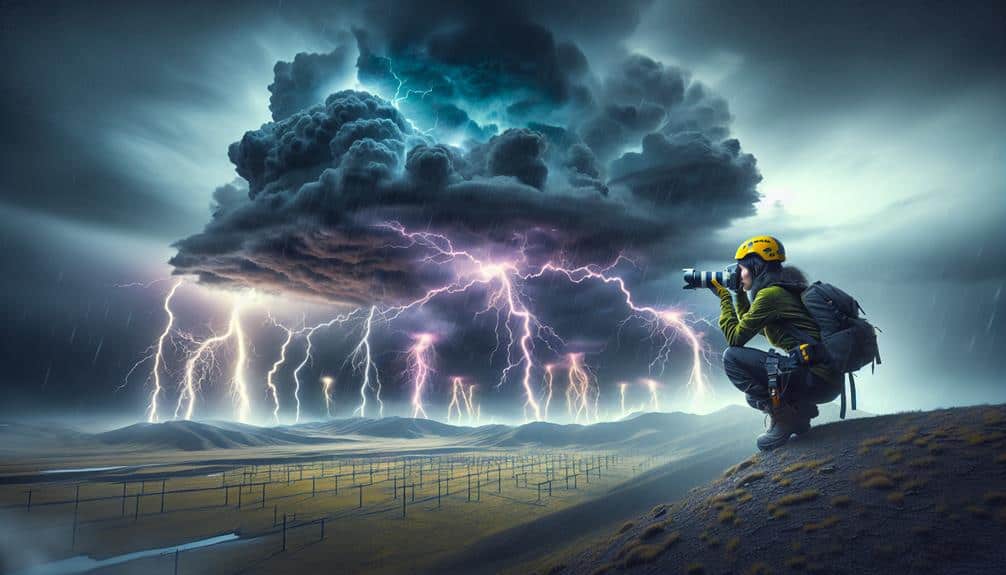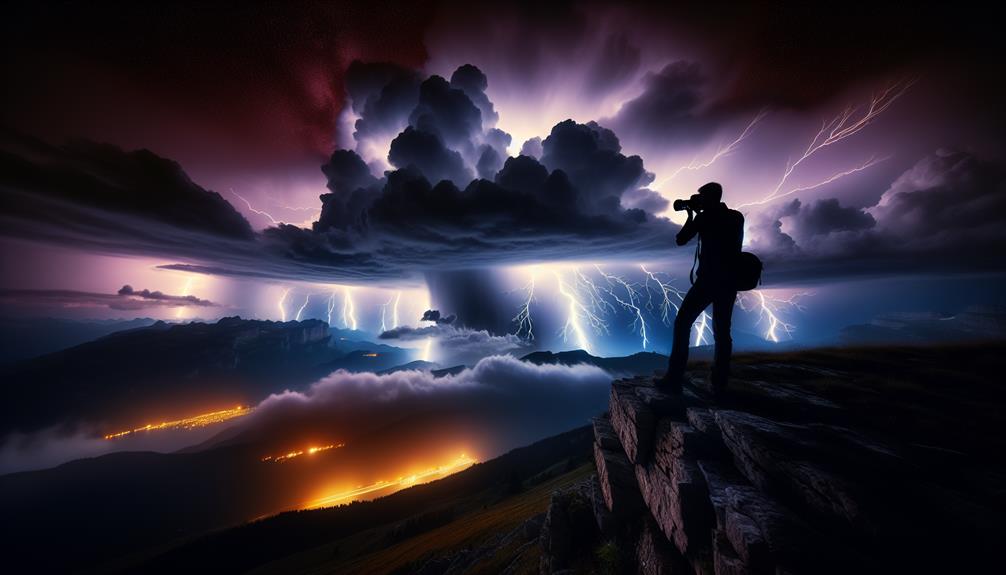Capturing striking lightning photos demands a keen eye for composition and the right equipment. We begin with a full-frame DSLR or mirrorless camera, combined with a wide-angle lens and a sturdy tripod. Timing is crucial, so we monitor weather patterns and utilize apps to forecast strikes. Safety is paramount – elevated vantage points offer breathtaking views. We apply the Rule of Thirds, leading lines, and integrate foreground elements for depth. Achieving the perfect balance between light and darkness with meticulous exposure settings ensures the lightning is highlighted. Let's delve into how experimenting with angles and mastering these techniques can transform our storm photography.
Key Points
- Use the Rule of Thirds to create balanced and dynamic lightning compositions.
- Incorporate leading lines to guide the viewer's eye towards the lightning strike.
- Include foreground elements to add depth and context to your lightning shots.
- Experiment with angles to capture unique and dramatic lightning perspectives.
Choosing the Right Gear
When it comes to capturing striking lightning, we need to prioritize selecting the right camera and lens to handle the extreme conditions and rapid flashes. A full-frame DSLR or mirrorless camera with a high dynamic range and low noise at high ISO settings is ideal. Pair it with a wide-angle lens, preferably with a fast aperture, to capture expansive sky views and detailed lightning bolts.
Gear maintenance is essential; our cameras and lenses must be clean and dry, especially when shooting in unpredictable weather. Essential accessories include a sturdy tripod to keep the camera steady during long exposures, a remote shutter release to minimize camera shake, and weatherproof covers to protect our gear.
For those on a budget, there are viable options and DIY solutions. An entry-level DSLR or mirrorless camera can still deliver excellent results if paired with a good prime lens. We can even create our own weatherproof gear covers using plastic bags and rubber bands, ensuring our equipment stays safe without breaking the bank.
Timing and Patience
Timing and patience are vital for capturing lightning; we must predict strikes by monitoring weather patterns and lightning maps.
It's vital to identify best waiting locations that offer a clear, unobstructed view while ensuring our safety.
Predicting Lightning Strikes
Understanding the patterns of atmospheric conditions allows us to strategically position ourselves to anticipate and capture the dramatic display of lightning. By mastering storm tracking and employing precise photography tips, we heighten our chances of snapping that perfect shot.
Weather apps are essential tools for this endeavor. They provide real-time updates on storm movements, aiding us in predicting lightning strikes. Here's how we can enhance our predictive accuracy and patience:
1. Study Weather Patterns:
Learn the behavior of storms in your region. Familiarize yourself with the types of clouds and atmospheric changes that precede lightning events.
2. Use Weather Apps:
Apps like RadarScope and Storm Shield give us detailed storm tracking data. They help us identify areas with high lightning activity, important for our composition techniques.
3. Monitor Local Alerts:
Stay tuned to local weather alerts. These notifications often come with insights into the intensity and duration of storms, helping us time our photography sessions.
4. Practice Patience:
Lightning photography demands patience. Position your camera, set your composition, and wait for nature to cooperate. Sometimes the best shots come after long periods of waiting, so stay focused and ready.
Optimal Waiting Locations
Selecting the perfect vantage point requires a blend of geographical knowledge and an intuitive sense for storm behavior. We must understand the interplay of weather conditions and topography to position ourselves effectively.
In remote locations, the vast, unobstructed skies offer dramatic compositions, but these spots demand heightened safety precautions. We should always stay aware of our surroundings and have a clear escape route, ensuring we're not caught off guard by fast-moving storms.
Urban settings present a different challenge. Cityscapes can frame lightning in striking ways, with skyscrapers and bridges adding visual interest. However, the density of buildings may obscure our view and make it harder to judge the storm's approach. It's essential to select high vantage points, like rooftops or elevated parks, while remaining mindful of the safety risks these areas pose.
Patience is key. We often have to wait through long periods of calm before capturing that perfect strike. Constantly monitoring weather conditions allows us to anticipate when the action will begin.
Finding the Perfect Location

Identifying an ideal vantage point is essential for successfully capturing the mesmerizing dance of lightning across the sky. We need to contemplate both remote locations and urban settings to maximize our chances of a stunning shot.
Remote locations offer an unobstructed view of the horizon and minimal light pollution, perfect for capturing the full brilliance of each lightning bolt. Urban settings, on the other hand, can provide a dramatic contrast between nature's fury and man-made structures, adding layers of context to our photos.
Here are a few tips to help us find that perfect spot:
- Safety first: Always prioritize safety by avoiding open fields, tall structures, and bodies of water during a storm. Look for a location that offers a clear view but also provides a safe retreat.
- Elevation matters: Higher ground can offer a broader perspective. Whether it's a hill in a remote area or a rooftop in the city, elevation can help capture more of the sky.
- Check the weather: Use weather apps to track storm movement and intensity. Knowing where the storm is headed can help us position ourselves effectively.
- Scout ahead: Familiarize ourselves with potential locations during daylight to identify the best angles and compositions for when the storm hits.
Framing Your Shot
When framing our shot, we should apply the rule of thirds to create a more dynamic composition.
Let's also utilize leading lines to draw the viewer's eye towards the lightning's dramatic impact.
Rule of Thirds
To harness the power of the Rule of Thirds, we must imagine our frame divided into nine equal segments, guiding our composition to create striking and well-balanced lightning shots. This grid helps us achieve artistic positioning and visual equilibrium, making our photos more dynamic and captivating.
When we place the key elements of our lightning shot along these lines or at their intersections, we enhance the overall composition and draw the viewer's eye more naturally. Here's how we can master this technique:
- Position the Lightning Bolt: Align the main lightning bolt along one of the vertical or horizontal thirds to create a balanced and captivating image.
- Foreground Interest: Place interesting elements like trees or buildings at one of the grid's intersections to add depth and context to our shot.
- Sky and Horizon: Use the horizontal thirds to position the horizon, giving either more prominence to the dramatic sky or to the ground, depending on the desired effect.
- Lightning Contrast: Make sure that the lightning contrasts sharply with the surrounding elements, enhancing the visual impact through creative framing.
Leading Lines Utilization
Building on our understanding of the Rule of Thirds, we can further enhance our lightning photography by strategically employing leading lines to naturally guide the viewer's eye through the frame. Leading lines are powerful tools that can transform a good photograph into a striking one by creating depth and directing attention.
When we explore symmetry, creative framing with leading lines can make our compositions more dynamic. For instance, roads, rivers, or even power lines can lead the viewer's gaze straight to the lightning strike. This technique not only emphasizes the main subject but also adds a layer of complexity to the image.
Perspective play is essential in this regard. By experimenting with different vantage points, we can discover unique angles that maximize the impact of leading lines. Shooting from a low angle might make the storm clouds appear more menacing, while a high vantage point can provide a dramatic overview of the landscape.
We should always be on the lookout for natural or man-made lines that can frame our shots creatively. Whether it's a row of trees, a fence, or the horizon itself, these elements can be strategically used to lead viewers right to the heart of the storm.
Negative Space Balance
Mastering the balance of negative space in our lightning photography can dramatically enhance the visual impact and overall composition of our shots. By thoughtfully framing our images, we can create striking visuals that draw the viewer's eye to the electrifying subject.
When we're out in the field, we need to keep a few things in mind:
- Color Contrast: A dark, stormy sky provides a perfect backdrop to highlight the vivid, bright bolts of lightning. This natural color contrast makes the lightning pop, creating a more compelling image.
- Minimalist Approach: Embracing minimalism in our composition helps eliminate distractions. By focusing on the lightning and the open sky, we allow the negative space to accentuate the power and intensity of the storm.
- Rule of Thirds: Positioning the lightning bolt along the grid lines or at their intersections can add dynamism to our shots. This technique leverages negative space to create a balanced yet dramatic composition.
- Foreground Elements: Including simple foreground elements, like a lone tree or a distant mountain, can provide context without overcrowding the frame. This balance enhances the narrative and depth of our photograph.
Using Leading Lines
Harnessing the power of leading lines in your lightning photography can guide the viewer's eye directly to the electrifying focal point. By integrating natural or man-made lines within the frame, we can create a compelling visual path that enhances the drama of the storm. Think about weather patterns and how they interact with the landscape. Roads, rivers, or even the jagged edges of mountains can lead the viewer's gaze toward the striking lightning bolt.
In landscape photography, leading lines are essential tools for visual storytelling. They provide a sense of depth and direction, drawing the viewer into the scene. Our creativity comes into play when we identify and utilize these lines effectively. For example, a winding path or a row of trees can subtly guide the eye and emphasize the raw power of the lightning.
Experimenting with different angles and perspectives can reveal hidden leading lines that transform a static image into a dynamic masterpiece. By consciously placing these elements in our compositions, we not only highlight the lightning but also create a harmonious balance within the frame.
This technique, when mastered, elevates our lightning photography to new heights, capturing the awe-inspiring beauty of nature's fury.
Balancing Light and Darkness
In the dance between light and darkness, we must meticulously calibrate our camera settings to capture the intense brilliance of lightning without losing the intricate details of the surrounding nightscape. Achieving this balance requires mastering exposure control and contrast adjustment to safeguard our shots are both dramatic and detailed.
Exposure Control: Start by setting your camera to manual mode. Adjust the shutter speed to a slower setting, around 10-30 seconds, to capture the lightning's full strike. Use a low ISO (100-200) to minimize noise in the dark areas.
Contrast Adjustment: Utilize your camera's histogram to find the right balance between the highlights and shadows. Aim for a well-distributed histogram to avoid blown-out highlights and excessively dark shadows.
Shadow Management: Pay attention to the foreground elements. Use a low-intensity fill light or adjust your aperture to bring out details in the shadows without overexposing the lightning.
Highlight Adjustment: To prevent the lightning from appearing as a washed-out streak, slightly underexpose the shot. This can be achieved by reducing the exposure compensation by around -0.3 to -0.7 stops.
Experimenting With Angles

To capture the most dynamic lightning shots, we must explore various angles to find the perfect vantage point that highlights both the electrical spectacle and the landscape's unique features. By seeking out creative perspectives, we can transform ordinary scenes into extraordinary works of art. Think about the composition as an artistic technique—each angle we choose can drastically alter the mood and impact of our photograph.
Unique viewpoints are essential for capturing the raw energy of a lightning strike. We should consider crouching low to the ground to emphasize the sky's vastness or finding elevated spots that offer a sweeping panorama. These experimental approaches can help us include interesting foreground elements like trees, buildings, or even water reflections, which add layers of depth and intrigue to our shots.
When experimenting with angles, don't be afraid to take risks. Sometimes, the most unexpected positions yield the most striking results. We can employ a wide-angle lens to capture the full breadth of a storm or zoom in to isolate the lightning bolt's intricate details.
Frequently Asked Questions
How Can I Ensure My Safety While Photographing Lightning?
To guarantee our safety while photographing lightning, we should follow key safety precautions: avoid open areas, use proper gear like a tripod and remote shutter, and monitor weather updates. Let's capture those stunning shots without compromising freedom or safety.
What Post-Processing Techniques Enhance Lightning Photos?
Did you know 80% of lightning photos improve with post-processing? We should start by enhancing contrast and adjusting exposure. These techniques highlight the dramatic details, creating stunning, powerful images that truly capture the storm's intensity.
How Do I Protect My Camera From the Elements?
When discussing camera protection, we must invest in weatherproof gear like rain covers and lens hoods. We can also use silica gel packs to prevent moisture buildup. Ensuring our gear's safety lets us focus on creativity and freedom.
Can Smartphone Cameras Capture High-Quality Lightning Shots?
When it comes to capturing lightning shots with a smartphone, it's a bit like finding a needle in a haystack. With the right camera settings and ideal lighting conditions, we can achieve surprisingly high-quality results.
What Legal Considerations Should I Be Aware of When Photographing Storms?
We must respect privacy rights and avoid trespassing when photographing storms. Additionally, guarantee our actions don't cause property damage. Always check local laws to avoid legal issues and maintain freedom while capturing nature's fury.


